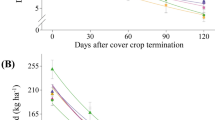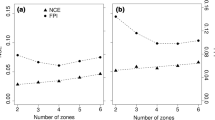Abstract
Increasing nitrogen (N) immobilization and weed interference in the early phase of implementation of conservation agriculture (CA) affects crop yields. Yet, higher fertilizer and herbicide use to improve productivity influences greenhouse gase emissions and herbicide residues. These tradeoffs precipitated a need for adaptive N and integrated weed management in CA-based maize (Zea mays L.)—wheat [Triticum aestivum (L.) emend Fiori & Paol] cropping system in the Indo-Gangetic Plains (IGP) to optimize N availability and reduce weed proliferation. Adaptive N fertilization was based on soil test value and normalized difference vegetation index measurement (NDVM) by GreenSeeker™ technology, while integrated weed management included brown manuring (Sesbania aculeata L. co-culture, killed at 25 days after sowing), herbicide mixture, and weedy check (control, i.e., without weed management). Results indicated that the ‘best-adaptive N rate’ (i.e., 50% basal + 25% broadcast at 25 days after sowing + supplementary N guided by NDVM) increased maize and wheat grain yields by 20 and 14% (averaged for 2 years), respectively, compared with whole recommended N applied at sowing. Weed management by brown manuring (during maize) and herbicide mixture (during wheat) resulted in 10 and 21% higher grain yields (averaged for 2 years), respectively, over the weedy check. The NDVM in-season N fertilization and brown manuring affected N2O and CO2 emissions, but resulted in improved carbon storage efficiency, while herbicide residuals in soil were significantly lower in the maize season than in wheat cropping. This study concludes that adaptive N and integrated weed management enhance synergy between agronomic productivity, fertilizer and herbicide efficiency, and greenhouse gas mitigation.

Similar content being viewed by others
References
Bhatia, A., Sasmal, S., Jain, N., Pathak, H., Kumar, R., & Singh, A. (2010). Mitigating nitrous oxide emission from soil under conventional and no-tillage in wheat using nitrification inhibitors. Agriculture, Ecosystem & Environment, 136, 247–253.
Bhatia, A., Ghosh, A., Kumar, V., Tomer, R., Singh, S. D., & Pathak, H. (2011). Effect of elevated tropospheric ozone on methane and nitrous oxide emission from rice soil in north India. Agriculture, Ecosystems & Environment, 144, 21–28.
Bhattacharyya, R., Das, T. K., Sudhishri, S., Dudwal, B., Sharma, A. R., Bhatia, A., & Singh, G. (2015). Conservation agriculture effects on soil organic carbon accumulation and crop productivity under a rice–wheat cropping system in the western Indo-Gangetic Plains. European Journal of Agronomy, 70, 11–21.
Bijay-Singh, Sharma, R. K., Kaur, J., Jat, M. L., Yadvinder-Singh, Varinderpal-Singh, et al. (2011). In-season estimation of yield and nitrogen management in irrigated wheat using a hand-held optical sensor in the Indo-Gangetic plains of South Asia. Agronomy for Sustainable Development, 31, 589–603.
Bijay-Singh, Varinderpal-Singh, Purba, J., Sharma, R. K., Jat, M. L., Yadvinder-Singh, et al. (2015). Site-specific fertilizer nitrogen management in irrigated transplanted rice (Oryza sativa) using an optical sensor. Precision Agriculture, 16, 455–475.
Cao, Q., Cui, Z., Chen, X., Khosla, R., Dao, T. H., & Miao, Y. (2012). Quantifying spatial variability of indigenous nitrogen supply for precision nitrogen management in small scale farming. Precision Agriculture, 13, 45–61.
Chauhan, B. S., Singh, R. G., & Gulshan, M. G. (2012). Ecology and management of weeds under conservation agriculture: A review. Crop Protection, 38, 57–65.
Das, T. K., & Yaduraju, N. T. (1999). Effect of weed competition on the growth, nutrient uptake and yield of wheat as affected by irrigation and fertilizers. Journal of Agricultural Science (Cambridge), 133, 45–51.
Das, T. K., Bhattacharyya, R., Sharma, A. R., Das, S., Saad, A. A., & Pathak, H. (2013). Impacts of conservation agriculture on total soil organic carbon retention potential under an irrigated agro-ecosystem of the western Indo-Gangetic Plains. European Journal of Agronomy, 51, 34–42.
Dendooven, L., Patino-Zúniga, L., Verhulst, N., Luna-Guido, M., Marsch, R., & Govaerts, B. (2012). Global warming potential of agricultural systems with contrasting tillage and residue management in the central highlands of Mexico. Agriculture Ecosystem and Environment, 152, 50–58.
Drinkwater, L. E., Janke, R. R., & Rossoni-Longnecker, L. (2000). Effects of tillage intensity on nitrogen dynamics and productivity in legume-based grain systems. Plant and Soil, 227, 99–113.
Ellert, B. H., & Janzen, H. H. (2008). Nitrous oxide, carbon dioxide and methane emissions from irrigated cropping systems as influenced by legumes, manure and fertilizer. Canadian Journal of Soil Science, 88, 207–217.
Flower, K. C., Cordingley, N., Ward, P. R., & Weeks, C. (2013). Nitrogen, weed management and economics with cover crops in conservation agriculture in a Mediterranean climate. Field Crops Research, 132, 63–75.
Gupta, D. K., Bhatia, A., Kumar, A., Das, T. K., Jain, A., Tomer, R., Malyan, S. K., Fagodiya, R. K., Dubey, R., & Pathak, H. (2016). Mitigation of greenhouse gas emission from rice–wheat system of the Indo-Gangetic plains: Through tillage, irrigation and fertilizer management. Agriculture, Ecosystems and Environment, 230, 1–9.
IPCC. (2007). Synthesis Report of fourth assessment Report of the intergovernmental Panel on climate change. Cambridge: Cambridge University Press.
Küstermann, B., Munch, J. C., & Hülsbergen, K. J. (2013). Effects of soil tillage and fertilization on resource efficiency and greenhouse gas emissions in a long-term field experiment in southern Germany. European Journal of Agronomy, 49, 61–73.
Ladha, J. K., Dawe, D., Ventura, T. S., Singh, U., Ventura, W., & Wetanabe, I. (2000). Long-term effects of urea and green manure on rice yields and nitrogen balance. Soil Science Society of American Journal, 64, 1993–2001.
Lal, R. (2015). Sequestering carbon and increasing productivity by conservation agriculture. Journal of Soil Water Conservation, 70(3), 55A–62A.
Lundy, M. E., Pittelkow, C. M., Linquist, B. A., Liang, X., van Groenigen, K. J., Lee, J., et al. (2015). Nitrogen fertilization reduces yield declines following no-till adoption. Field Crops Research, 83, 204–210.
Mashingaidze, N., Madakadze, C., Twomlow, S., Nyamangara, J., & Hove, L. (2012). Crop yield and weed growth under conservation agriculture in semi-arid Zimbabwe. Soil Tillage Research, 124, 102–110.
Mulvaney, R. L., Khan, S. A., & Ellsworth, T. R. (2006). Need for a soil-based approach in managing nitrogen fertilizers for profitable corn production. Soil Science Society of American Journal, 70, 172–182.
Nichols, V., Verhulst, N., Cox, R., & Govaerts, B. (2015). Weed dynamics and conservation agriculture principles: A review. Field Crops Research, 183, 56–68.
Pittelkow, C. M., Linquist, B. A., Lundy, M. E., Liang, X., Van Groenigen, K. J., Lee, J., et al. (2015). When does no-till yield more? A global meta-analysis. Field Crops Research, 183, 156–168.
Powlson, D. S., Stirling, C. M., Thierfelder, C., White, R. P., & Jat, M. L. (2016). Does conservation agriculture deliver climate change mitigation through soil carbon sequestration in tropical agro-ecosystems? Agriculture Ecosystem & Environment, 220, 164–174.
Raun, W. R., Solie, J. B., Johnson, G. V., Stone, M. L., Mullen, R. W., Freeman, K. W., et al. (2002). Improving nitrogen use efficiency in cereal grain production with optical sensing and variable rate application. Agronomy Journal, 94, 815–820.
Rouse, J.W., Hass, R.H., Schell, J.A., & Deering, D.W. (1973). Monitoring vegetation systems in the Great Plains with ERTS, Third ERTS symposium, NASA, SP-3511-309–317.
Saad, A. A., Das, T. K., Rana, D. S., Sharma, A. R., Bhattacharyya, R., & Lal, K. (2016). Energy auditing of maize-wheat-greengram cropping system under conventional and conservation agriculture in irrigated north-western Indo-Gangetic Plains. Energy, 116, 293–305.
Sapkota, T. B., Majumdar, K., Jat, M. L., Kumara, A., Bishnoi, D. K., et al. (2014). Precision nutrient management in conservation agriculture based wheat production of Northwest India: Profitability, nutrient use efficiency and environmental footprint. Field Crops Research, 155, 233–244.
Singh, S., Ladha, J. K., Gupta, R. K., Bhushan, L., Rao, A. N., Sivaprasad, B., & Singh, P. P. (2007). Evaluation of mulching, intercropping with Sesbania and herbicide use for weed management in dry-seeded rice (Oryza sativa L.) Crop Protection, 26, 518–524.
Sommer, R., Thierfelder, C., Tittonell, P., Hove, L., Mureithi, J., & Mkomwa, S. (2014). Fertilizer use should not be the fourth principle to define conservation agriculture. Field Crops Research, 169, 145–148.
Sondhia, S. (2014). Herbicides residues in soil, water, plants and non-targeted organisms and human health implications: An Indian perspective. Indian Journal of Weed Science, 46(1), 66–85.
Subbiah, B. V., & Asija, G. L. (1956). A rapid procedure for the estimation of available nitrogen in soils. Current Science, 25(8), 259–260.
Susha, V. S., Das, T. K., & Sharma, A. R. (2014). Weed management in maize in western Indo-Gangetic Plains through tank-mix herbicide application. Indian Journal of Agricultural Science, 84(11), 1363–1368.
The Montpellier Panel. (2013). Sustainable intensification: A new paradigm for African agriculture. London: Imperial College.
Vanlauwe, B., Wendt, J., Giller, K. E., Corbeels, M., Gerard, B., & Nolte, C. (2014). A fourth principle is required to define conservation agriculture in sub-Saharan Africa: The appropriate use of fertilizer to enhance crop productivity. Field Crops Research, 155, 10–13.
WHO. (2009). The WHO Recommended Classification of Pesticides by Hazard and Guidelines to Classification. World Health Organisation.
Yadvinder-Singh, Singh, M., Sidhu, H. S., Humphrey, E., Thind, H. S., Jat, M. L., Blackwell, J., & Singh, V. (2015). Nitrogen management for zero till wheat with surface retention of rice residues in north-west India. Field Crops Research, 184, 183–191.
Acknowledgements
The first author acknowledges the Africa Union & Indian Government for the fellowship. The Indian Council of Agricultural Research (ICAR)–Indian Agricultural Research Institute, New Delhi, is gratefully acknowledged for providing the facilities for this work.
Author information
Authors and Affiliations
Corresponding author
Rights and permissions
About this article
Cite this article
Oyeogbe, A.I., Das, T.K., Bhatia, A. et al. Adaptive nitrogen and integrated weed management in conservation agriculture: impacts on agronomic productivity, greenhouse gas emissions, and herbicide residues. Environ Monit Assess 189, 198 (2017). https://doi.org/10.1007/s10661-017-5917-3
Received:
Accepted:
Published:
DOI: https://doi.org/10.1007/s10661-017-5917-3




